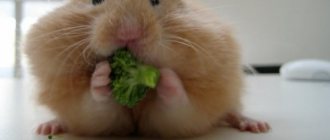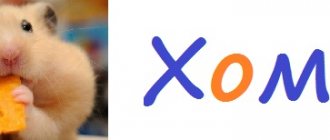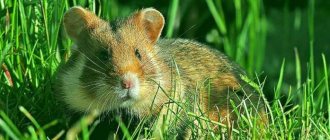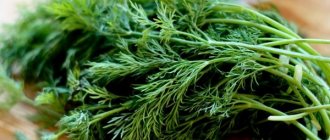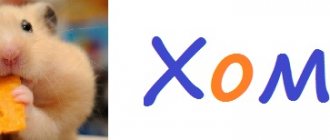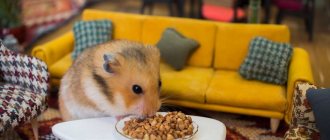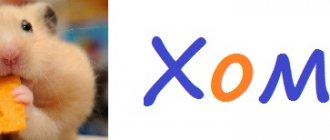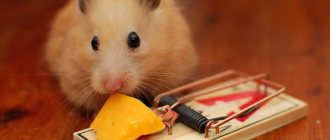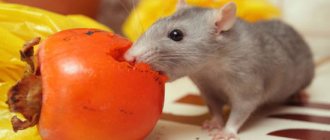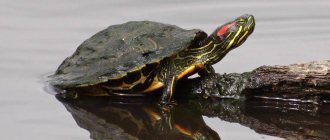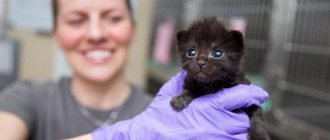The natural food of small rodents living in nature are seeds of cereal plants, legumes, berries, fresh stems and leaves, and insect larvae. Animals kept at home are forced to eat what their owner feeds them. The principle “proper nutrition is the key to health” should apply not only to people, so before getting a pet, you need to think about its diet. For example, you need to understand whether hamsters can eat seeds? In what form is it better to offer your pet a treat? There are several possible answers to these questions.
Sunflower
Sunflower seeds are a component of specialized food mixtures for rodents, because they are part of the animals' natural diet. The seeds contain beneficial substances that have a positive effect on the heart, blood vessels, and nervous system of the baby’s body. This:
- vitamins (A, E, D and group B);
- minerals (iodine, zinc, calcium, iron, etc.);
- amino acids;
- polyunsaturated fatty acids.
Therefore, the answer to the question whether it is possible to give your pet sunflower seeds will be positive. You even need to give these seeds to your hamster. But there is a limitation. Since sunflower grains contain 30% vegetable oil, they are very high in calories. It is not recommended to feed your pet them often. This will lead to health problems associated with obesity.
Dangerous treat
For a rodent, among the many useful seeds, there are dangerous and even fatal ones. Prohibited seeds: pits of cherries, cherries, plums, apples, almonds and apricots; they contain hydrocyanic acid, which is very dangerous for small animals even in small quantities. Only fruit pulp is allowed to be fed.
In addition to the dangerous contents of fruit seeds, improperly stored food mixture can cause harm to the health of a small pet. Moldy, rancid seeds can cause poisoning. Do not allow food to contain sugar, salt or flavorings.
Pumpkin
Can hamsters have pumpkin seeds? Pumpkin seeds are also a source of valuable nutrients. A whole complex of beneficial components of these grains helps lower cholesterol levels, maintain blood composition within normal limits, and establish proper functioning of the heart and vascular system. In addition to vitamins, calcium, phosphorus, iron, copper, selenium, zinc, magnesium and potassium, pumpkin seeds contain the substance cucurbitin. It has an anthelmintic effect. Including pumpkin seeds in your baby’s diet will protect him from parasites, maintain health, and prolong life.
Pits from apples, cherries, peaches, apricots and plums
Apple seeds contain a very dangerous substance - amygdalin glycoside. The glycoside amygdalin is broken down by gastric juice and forms hydrocyanic acid. This acid is classified as a very strong poison - cyanide. One seed contains a small amount of this substance and it is not dangerous for humans. But for a small rodent this will be a lethal dose.
Cherries, peaches, apricots and plums also contain a toxic substance called cyanide in their pits. If you give your pet such a bone and he gnaws it, chews it, or otherwise damages the bone, the animal will be exposed to hydrogen cyanide.
Therefore, pits from apples, cherries, peaches, apricots and plums are strictly contraindicated for a hamster.
Melon and watermelon
What seeds are best to offer to your pet? Watermelon or melon? The seeds of both of these melons can be fed to hamsters. Melons will especially benefit pregnant females because they contain folic acid, which is necessary for the proper development of the offspring. Components such as vegetable proteins and fats are necessary to build the muscle tissue of the animal.
Watermelon seeds are rich in vitamin D, polyunsaturated fatty acids, as well as other elements necessary for a full life for an animal.
What should you not feed hamsters?
We have already written that domestic hamsters should absolutely not be given
any exotic fruits, hot, salty, peppery or too sweet, as well as fatty foods, for which the animal’s small digestive system is not designed at all.
This means that honey, any sweets, kozinaki, ice cream, halva and shortbread dough are contraindicated for a hamster: for a pet this is a slow-killing poison. The rodent's diet should be free of any milk, butter, cream, kefir and sour cream. Cabbage, fried meat, chocolate products, pasta, bread, breadcrumbs are contraindicated for your pet, as they contain an ingredient that is dangerous for the hamster. Yes, yes, don’t be surprised, hamsters should absolutely not be given bread, only grain.
Naturally, garlic, hot peppers, onions, and sorrel should not be given to a rodent. Do not forget about melons and watermelons, as well as apricot or cherry pits, which contain acid that is harmful to the hamster.
Every time, make sure that the hamster eats only fresh, unspoiled food and feed, ripe fruits and vegetables, and has the required amount of fresh water. This is the only way your playful pet will delight you and your family for a long time with its cheerfulness, activity and healthy appearance!
Apples are one of the most popular fruits in our latitude. We meet him almost every day in shops, bazaars, and in our own garden. It is a relatively cheap, easily accessible, tasty food for many pets.
Heat-treated seeds
Roasted sunflower seeds (often salted) are often present on our table. They are easier to peel and have a more pleasant taste than raw ones. But this is for people. Can hamsters eat roasted plant seeds? Yes, but little by little. Due to the effects of heat, most of the beneficial substances were destroyed, but a lot of fat remained, which, if consumed in large quantities, will cause obesity. You cannot treat your pets to food containing salt, so fried salted seeds are contraindicated.
It is better to feed your pet raw seeds, which rodents eat in nature. This is a familiar, healthy food that is guaranteed not to cause problems with your well-being.
Do not forget that grain mixtures should make up only part of the animal’s diet, because with all the variety of useful components, they cannot provide the body with everything it needs. Be sure to feed your baby fresh grass (grown in an environmentally friendly place), pieces of vegetables, fruits, and berries.
Zucchini for a hamster - benefit or harm?
Zucchini is a fairly affordable vegetable in season. It has beneficial nutritional properties. This product contains vitamins of groups PP, C, B. It contains minerals: copper, phosphorus, magnesium, potassium and many more macro- and microelements.
Zucchini is rich in fiber and other dietary fibers, which actively remove waste, toxins and excess fluid from the body. It lowers cholesterol levels in the blood, which is good for blood vessels, and also stimulates the gastrointestinal tract.
Zucchini is a low-calorie vegetable. It does not contain fat - indispensable for the diet of people with extra pounds. It is recommended for diabetes. It is also a hypoallergenic product recommended for the first feeding of newborn babies.
Due to its easy digestibility and hypoallergenicity, you can safely treat your hamster with it.
In what form can you give your pet zucchini?
The hamster will be very happy to crush the fresh zucchini pulp. Of course, the vegetable must be fresh and well washed. There is no need to cook it, everything is eaten raw. It is good to add other juicy vegetables to the menu with zucchini - beets, cucumbers, carrots, tomatoes, carrots and pumpkin.
What portion is optimal?
Zucchini doesn't stay fresh for long. This is a quickly perishable vegetable. A small portion of zucchini is placed in the feeder. Make sure your hamster eats it right away, otherwise remove any leftovers from the cage. Because the hamster will hide them in his bins, and he will begin to rot there. Your hamster can get food poisoning and even die if it eats stale food.
It’s good if the vegetables are seasonal, grown in your own gardens, without the use of harmful pesticides. When buying a product on the market, make sure that the zucchini peel has not been subjected to special treatment, which gives the vegetable a beautiful appearance.
For the safety of your pet, if you don’t know anything about this vegetable, wash it thoroughly before feeding it and peel the skin well. They contain the highest concentration of harmful chemicals.
Important! You should not give canned zucchini to your pets . For the marinade, you always use a large amount of spices, hot seasonings, vinegar and salt.
For newborn hamsters, you can offer zucchini puree as complementary food. This dish is recommended for feeding babies up to six weeks of age and sick/weak hamsters.
Depending on the breed, the portion should be dosed. Miniature Djungarian hamsters should be given smaller, juicy portions to avoid digestive problems.
Zucchini seeds - is it possible or not?
Zucchini seeds are similar in composition to pumpkin seeds. They are suitable for eating with the main diet. But since they contain a high fat content, this should be done carefully: No more than two or three seeds per day.
Vintage basket
Here we are dealing with a representative design in the style of modern rural fashion. Best suited for lovers of cycling or short distance travel on scooters. The basket itself is woven from flexible willow and equipped with an openwork wire lid, which prevents the cat from wanting to get out while moving. At the first glance at such a carrier, one is reminded of idyllic pictures from centuries ago, when food from the market was transported in a similar way on bicycles. The entire structure is conveniently attached to the steering wheel using leather straps and does not require much time for preparation.
The advantage of the option under consideration is, of course, its original design and originality. The downside is limited functionality. Although, if desired, the basket can be used for its intended purpose.
Price – 1,128 – 1,708 rubles.
What not to give
Although Syrian hamsters are omnivores, there are many products whose introduction into the menu will have a bad effect on the health of the animal and can even cause death. To avoid such a fate, you need to know exactly which foods are prohibited from being included in your diet:
- Sugar, salt, spices, herbs, artificial food additives.
- Sweets, chocolate, juices.
- Nuts, seeds of any fruit.
- Sour plants.
- Citrus and exotic fruits.
- Coniferous tree branches.
- Dairy products, except kefir and cottage cheese.
- Fresh baked goods.
- Canned food, smoked meats, preserves.
- Food intended for other animals or birds.
- Chestnuts, almonds, mushrooms.
You cannot catch insects on your own to feed your pet, or allow him to get his own food on the street.
If you feed your Syrian hamster correctly, excluding prohibited foods, the rodent will be active, cheerful and healthy. It is important to provide your pet with a balanced diet, since its well-being and life expectancy depend on it.
Can Djungarians have sesame seeds?
WHAT IS POSSIBLE
OR SHOULD OUR HAMMERS NOT EAT?
2. Seeds: sunflower (not roasted), pumpkin, melon, sesame
.
Interesting materials:
How much does the Easy 350 original cost? How much does Easy Boost cost? How much does zucchini cost per 1 kg? How much does cocoa cost in Pyaterochka? How much does Cal of Duty Modern Warfare 2022 cost? How much does KAMAZ land cost in Novosibirsk? How much does an at-home IV cost in 2022? How much does an at-home drip for binge drinking cost? How much does a capsule hotel cost in Pulkovo? How much does a capsule hotel cost in Vnukovo?
Is it possible for Djungarian hamsters
The Dzhungarik should eat the same as a representative of any other breed. He should eat fresh greens, cereal mixtures, nuts, berries and fruits. Djungarian hamsters can be given banana in small quantities once a week.
For active life, the animal needs to consume sugar. Offer the dwarf a banana, but not the whole one. The treat contains increased levels of glucose. Its excess can cause obesity and diabetes.
You should not feed your Syrian sweet morsels during hibernation. During this time, the digestive system works slowly. Heavy, sticky food will harm it.
Food norm
Rodents are predominantly nocturnal, and their main meal of the day occurs in the evening. The amount of food depends on the size of the animal. It is advisable to feed your hamster at home twice a day. At the same time, “Syrians” should be given one tablespoon of the mixture in the morning and evening, and dwarf breeds (Djungarians, Campbell’s) should be given one teaspoon of the mixture. In the evening, you can put vegetables or fruits in the feeder, and in the morning you can remove uneaten leftovers from your pet’s home.
It is important to understand that food for a hamster is not only a nutritional element, but also an object of strategic reserves. If the food offered to your pet quickly disappears from the feeder, this does not mean that the hamster is eating too much
He hides some products for a rainy day. From time to time, it is necessary to inspect the “fluffy”’s home and remove excess food, especially that which quickly spoils. And so that your pet is not so upset about parting with “supplies”, you can leave a few grains or seeds in the “pantry”.
In what form is it better to give the vegetable?
In its natural form, the pulp contains the maximum amount of vitamins and nutrients.
Hamsters are quite capable of digesting raw pumpkin. However, this product may be too much of a burden for the small organism of a domestic rodent, so it is not worth offering it every day. Important! Long-term consumption of orange treats will affect the color of the hamster - yellowness will appear or the saturation of the natural yellow tint of the fur will increase.
Pet pumpkin can be boiled, steamed or baked in the oven. A boiled or baked dish can be served in pieces or as a puree. During heat treatment, the use of salt, sugar, spices and oil is prohibited in order to avoid additional stress on the animal’s liver.
Canned vegetables should not be offered to your pet.
Rules for feeding permitted products
The diet of Djungarian hamsters should be varied: the same foods should not be given day after day (except for dry food). It is optimal if the hamster receives dry, juicy and protein food every day. You cannot have a “vegetable” or “meat” day.
Djungarians love to stock up, so it is not recommended to give treats in large pieces: the product will deteriorate and rot if buried in the house. Inventory audits are carried out regularly. A piece of 1 cm in size will be optimal for a dwarf hamster.
How often can you feed your dwarf with additions to dry food?
- fruits and berries – once every 2 weeks;
- greens - every other day, preferably dried;
- vegetables - white or green every day (zucchini, Jerusalem artichoke, cucumber, turnip) others (pumpkin, carrots) - 2 times a week;
- nuts and seeds – rarely, as a delicacy;
- meat, eggs - once a week.
The recommendations do not take into account special needs: for example, a pregnant female can eat protein foods 2-3 times a week.
When feeding vegetables and fruits, preference is given to seasonal products. All succulent food is not only washed thoroughly, but they try to get rid of the “chemical” component (nitrates, pesticides). The greens are soaked, the apple is peeled.
In winter, you can’t help but think about what to feed the dzhungarik: overseas tasteless tomatoes and it’s scary to eat yourself. A good alternative to greenhouse vegetables would be oat, wheat, sunflower sprouts, and greens frozen from the summer.
